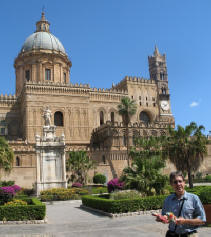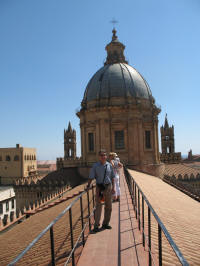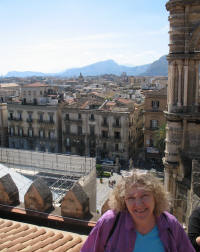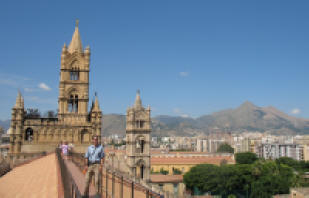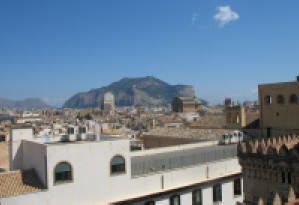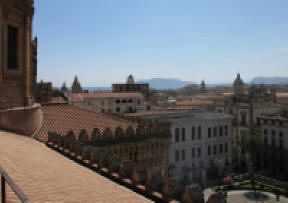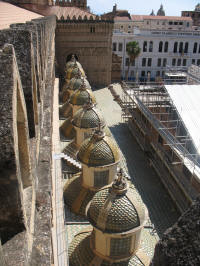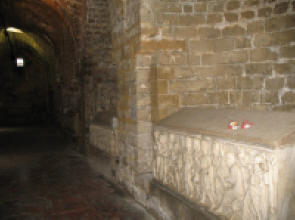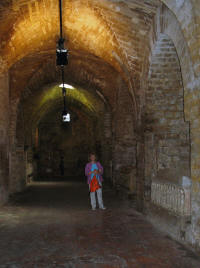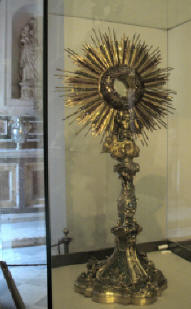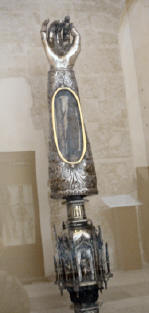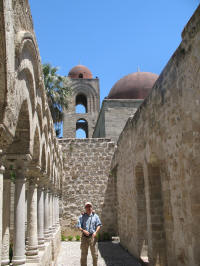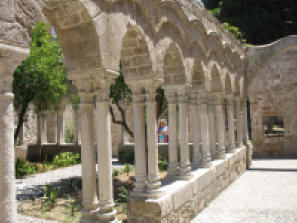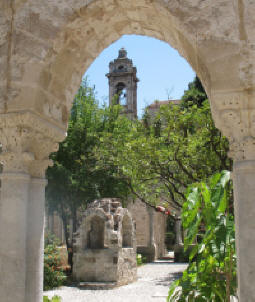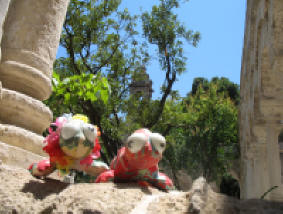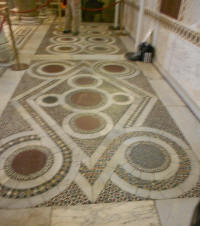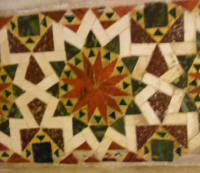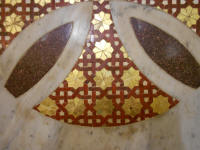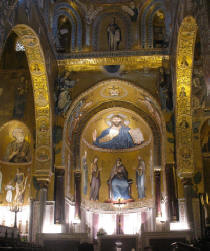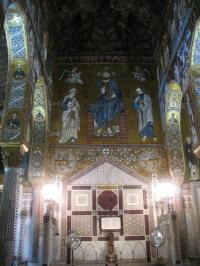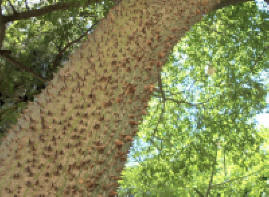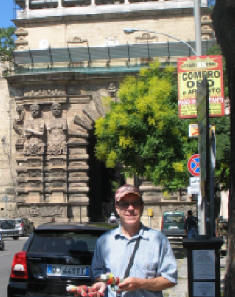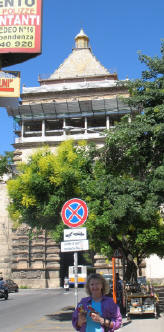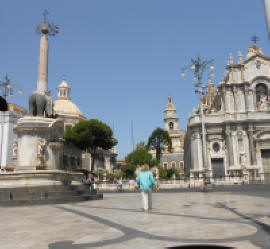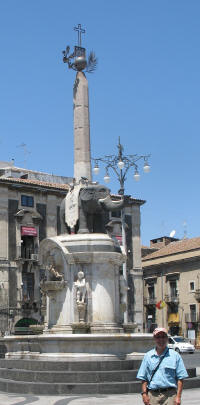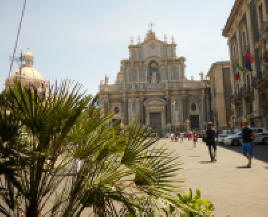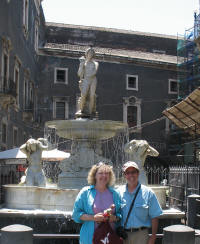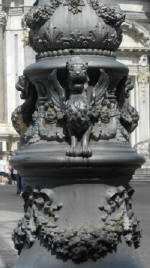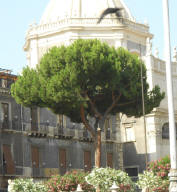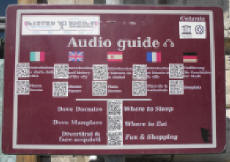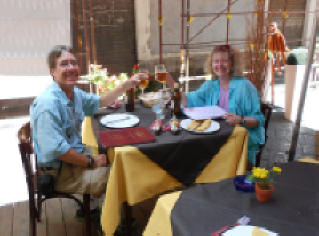|
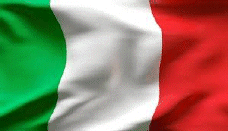 |
Sicily
2014
|
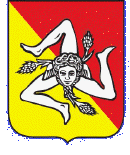 |
|

(Most all of the pictures are linked to their larger
size) |
Day 1:
Arrive Palermo
in the afternoon
Day 2:
Palermo
Hop on - Hop off bus
Day 3:
Check out & get car
Segesta
Erice
Day 4:
Check out & drive to
Selinunte then to
Agrigento
Day 5:
All day in Agrigento
(Valley of the Temples)
Day 6:
Check out & drive to
Piazza Armerina
then to Acireale / Etna |
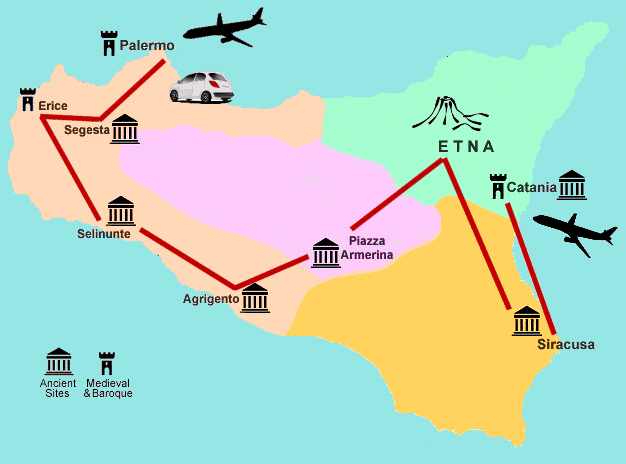 |
Day 7:
All day at Etna
Day 8:
Explore Acireale &
take an afternoon to relax
Day 9:
Check out & drive to
Siracusa (Syracuse)
visit Ortygia (Ortigia)
Day 10:
Siracusa (Syracuse)
Day 11:
Check out & drive to
Catania
Drop off car & see city
Day 12:
Fly home
|
Sicily is a large volcanic island located at the tip of the boot of
Italy. Because of its strategic location, it was invaded, conquered
and taken over time after time. Each conqueror left their cultures'
influence on the architecture, people, and government. We saw ruins
and artifacts from the original people (including Sikanians,
Elymains, and Ausonians circa 3,800 BC), the Carthaginians & Greeks
(400s BC), the Romans (200s BC). Then came a long series of
invaders, including the Byzantines, Arabs, Normans, and Bourbons. In
1860 Italy was undergoing a unification process and Sicily became
part of Italy. By 1949, Sicily was granted a special autonomous
status that endures today. |
  top
top
 
_________________________________________________________________________
Day 1:
Arrive Palermo
in the afternoon
Hotel
Florio OperaWe left from
Roanoke in the afternoon. Our first connection was in Charlotte,
then on to Rome, and finally Palermo, Sicily - landing in the
afternoon of the next day. They had completely changed the planes
and flights three times in the two weeks before we left - it was
nice to get there! Bob bought tickets on the bus from the airport to
the square near our hotel, so it was off the plane and onto a bus -
a few walk-abouts before we got our bearings, but a great time and
lovely weather. We dropped our bags and set out to do a
mini tour looking in shops in our area, then set off for food under
an umbrella on a street or plaza close by. Got
to bed early so we could get up early and explore.
|
  top
top
 
_________________________________________________________________________
Day 2:
Palermo
Hop on - Hop off bus
We had such a short time in Palermo that we decided to do a Hop on -
Hop off bus tour of the city. (We bought the tickets online from
home and had the printouts, saving us cost and time).
Our first stop was the Cathedral where we immediately climbed to
the the roof to have a look around. The spiral staircase was small
and stone, twisting its way up to the very top.
|
  top
top
 
_________________________________________________________________________
Day 3:
Check out & get car drive to
Segesta then
Erice, spend the night
La
Pineta Hotel
Although TripAdvisor said that our company (Thrifty,
booked through booking.com) was a definite "stay away from", we had
no problems
and they even worked with us to get an automatic - for
no extra cost! It was well appreciated! It was a Ciitgo Skoda
... whatever that is.
They drive on the left, like we do, but they don't
drive the way we do....
| On the highway (autostrata) they
come up on you at mach 1, then pass with no more than 6 inches
behind, beside, and then in front of your car.
The price of gas is so high that
there are few cars on the major roads. Added to that, if you
just stick to the left on the autostrada/highway (in the
really slow lane ... at the sped limit of +-70 mph), they blow
by you at over 100 mph plus (a couple of cars we
estimated at 130 to 150 mph). |
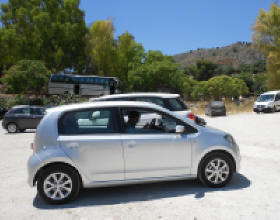 |
We had our GPS
with a European card we bought and installed. It worked great
once it figured out it was not in the U.S.
However, we just
wanted to smack it once or twice ... GPSs overseas that are
told to take you the fastest routes, rely on the speed limits
there and the assumption you can drive "like an Italian".
Hah!!! Not a chance we do towns and switchbacks at 50 kms! I
am sure the cars behind us were very annoyed - but they didn't
beep and passed when they could in places we never would!
|
|
We named our car Baby Brutus after the car
we rented on our 2008 trip.
The temple is visible just above the car hood in the larger
linked picture. |
|
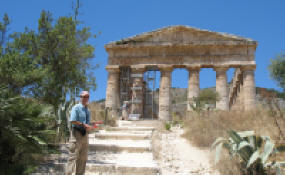 |
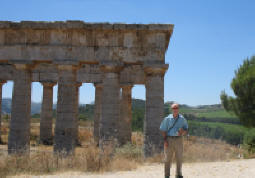 |
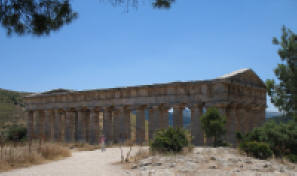 |
|
|
|
|
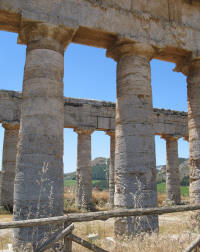 |
Segesta Temple & Theatre
The temple and theatre were built in the 5th
century BC by the Greeks. There are still remains of the city
that surrounded the two. The temple has 36 Doric columns. The
temple was never finished. Some archeologists believe that a
war with Selinunte interrupted the finishing it. Others say
that it was started to show other cities how much wealth
Segesta had so they would not invade the area; and when that
was accomplished, the process of building it was abandoned. |
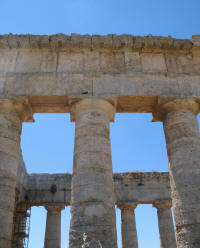 |
|
|
|
|
The theatre is carved out of the hill side
and has a spectacular view to the sea. Along the road between
the two is a majestic view of the temple. It is one of the
best preserved from this time period ... in fact, better
preserved than ones actually in Greece. |
|
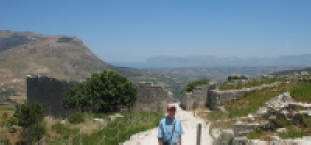 |
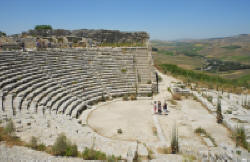 |
 |
|
|
|
|
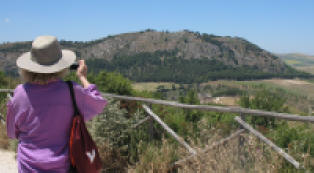 |
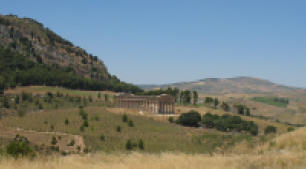 |
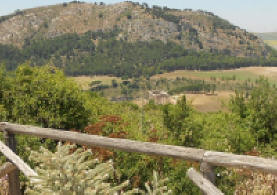 |
|
Still Day 3: Arrive Erice, Mid-Afternoon
|
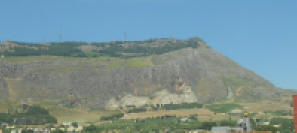 |
On the left, at the left tip, is the city of
Erice. It is tiny, triangular shaped with a warren of small
streets and plazas ... and some beautiful churches and a
fortress.
We had the rest of the day to explore. |
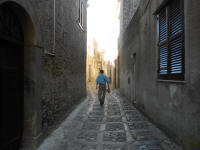 |
|
|
King Fredrick's Tower was the second
tower Bob climbed - and he did it at warp speed. I had barely
gotten out into the plaza when his head poked up over the top.
Amy and K&K had no intension of doing another 108 steps. |
|
 |
 |
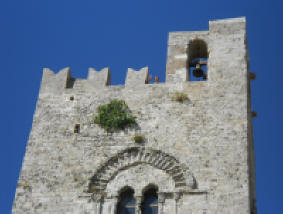 |
|
|
|
|
|
The Castle of Venus (Castello di Venere)
was built by the Normans in the 12th century.
It was built on the site of the temple of Venus Erycina, an
ancient goddess of fertility. |
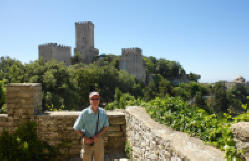 |
|
|
|
|
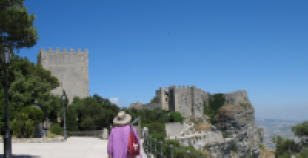 |
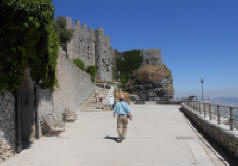 |
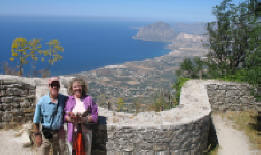 |
|
|
|
|
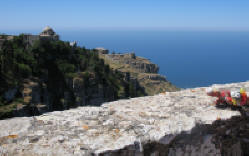 |
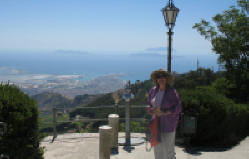 |
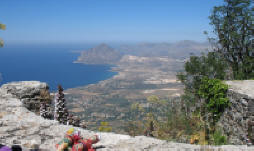 |
|
|
|
|
|
|
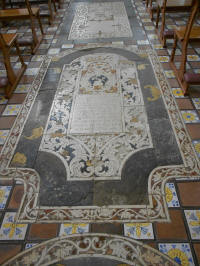 |
San Martino's Church
The outside of this church was unassuming -
just a red facing with an elegantly carved and embellished
doorway. But hen you walked in ...
Oh My.
The elegance of grey and white walls and
columns contrasting with the inlayed floors and the beautiful
ceiling was fantastic. |
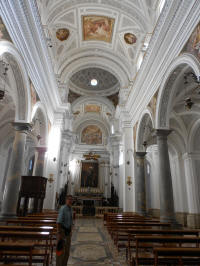 |
|
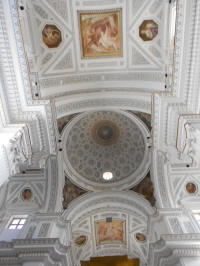 |
 |
|
|
|
|
|
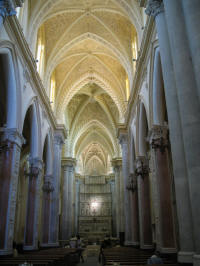 |
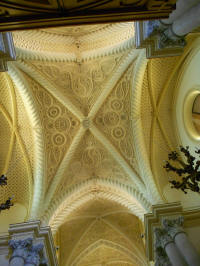 |
The Royal Church
Originally built from the materials from the
Temple of Venus in 1312. Over centuries it has been remodeled,
added onto, and reconfigured.
Interestingly, this was the first church we
visited that had real candles with real flame. Most all
churches were using some form of electric candle.
For us, candles with an on/off switch took
some of the power of the prayer / deep connection out if it.
As always, we lit a candle to those who have
gone before us and those that are still with us. |
|
|
|
|
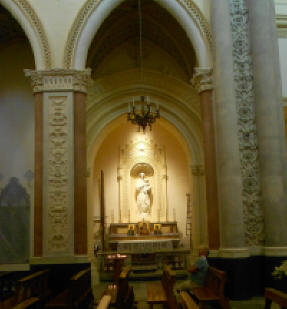 |
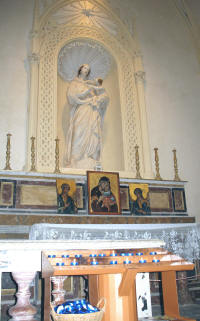 |
|
|
|
|
|
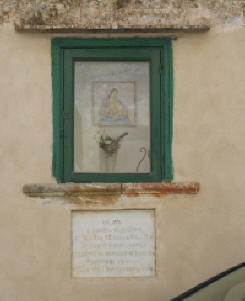 |
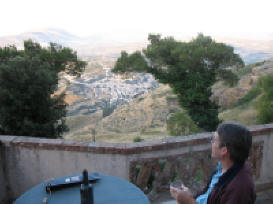 |
On our way to and from our hotel, there was
a little shrine to Mother Mary built into the wall. This is
very common to see oversees. They are usually maintained by
families or communities, adding flowers and candles on special
occasions or for different prayers.
Our hotel had a spectacular porch. After a
long day of touring, we came back and had a few beers while
watching the sun set and the town of Trapani light up below
us.
|
|
|
|
|
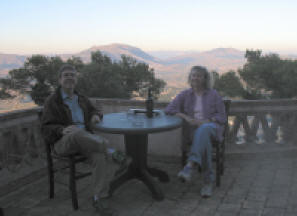 |
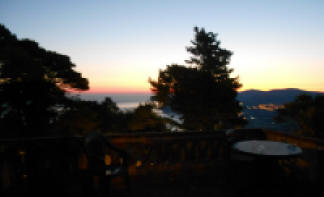 |
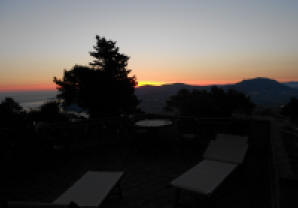 |
| |
|
|
|
  top
top
 
_________________________________________________________________________
|
Day 4:
Check out & drive to
Selinunte then to Agrigento
*Travel Tip: For the first time in our
adventures, we found that we were willing to tear out the pages of
our travel guide book (Eyewitness Travel: Sicily). We took only
those pages that we were going to be seeing for that day. It
lessened our carry weight significantly, and we did not have to
thumb through hundreds of pages to find what we needed. Just fold,
pocket, and go. We will keep the book (as we have all others), it
will be a lot more "worn", but still in our "travel section" on a
shelf.
|
Selinunte was founded in the 7th century BC.
It was one of the largest, most important, and wealthy cities
of its time. It is one of the best examples of the fusion of
the Phoenician and Greek cultures.
Overlooking the sea, it sat along well
traveled sea routes for trade of wears and ideas. As its power
and wealth grew, it became a rival to Segesta and Mozia, so in
409 BC, Carthage stepped in and destroyed it.
And it was forgotten for centuries.
It is not just a place to visit - it is an
experience.
Part of it sits on an acropolis, divided
into four quarters, and surrounded by a wall that is 4,132
feet long. The other part (divided by a low laying, small
harbor), has multiple other temples and ruins.
Temple E, built between 490-480 BC, is
considered to be one of the finest examples of Doric
architecture in all of Sicily.
On the left, Bob is standing next to not a
bowl or basin, but on of the top pieces to a long gone column.
The size and scope was incredible.
|
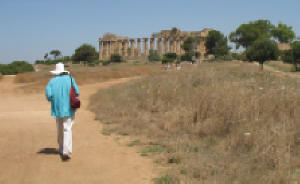 |
 |
|
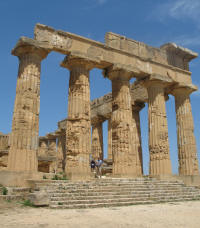 |
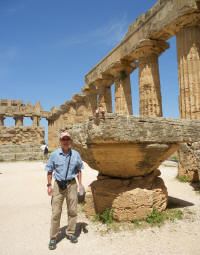 |
|
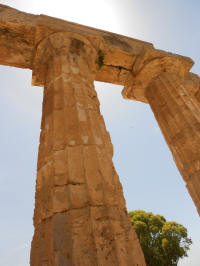 |
|
Below
are the ruins of Temple F (560-530 BC). Again, the pictures
simply do not do the size of these temples justice.
B&A, & K&K are standing next to one of the column sections
that has fallen. It is wider than we are! There were square
notches/holes in the center of the columns to help align them
and keep them stable. The ancient engineering is astounding!
The round circles with square bases are the tops of the
columns, turned over, and partially buried in the earth. |
|
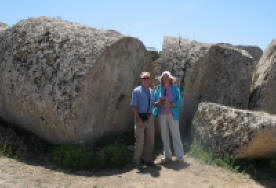 |
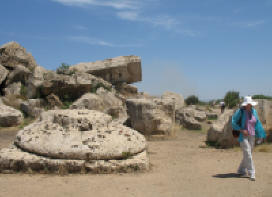 |
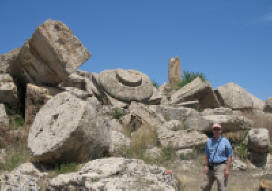 |
|
We took a little tram to the acropolis side.
The pictures below show the trail between the two sides of the
city looking toward the acropolis.
In the past, much of the valley was filled with water making it a
fantastic harbor. |
|
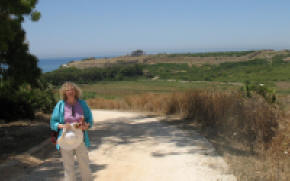 |
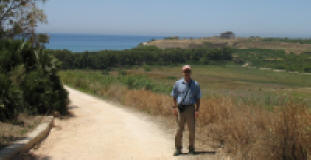 |
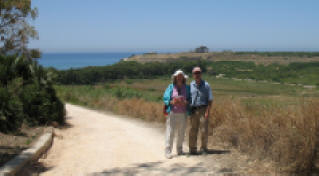 |
|
|
|
At the top were many more ruins of the
houses and shops that surrounded the main plazas and religious
sites.
Off to the side, and down at the beach, are
quaint little hotels, shops, and restaurants. |
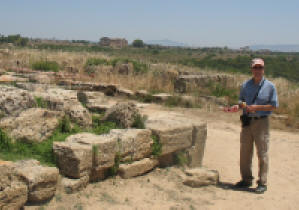 |
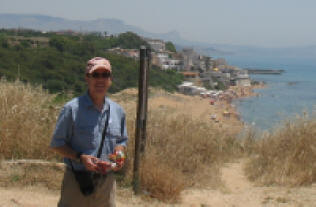 |
|
|
|
|
|
|
|
|
|
|
|
|
Check in Agrigento
B&B
Portatenea
|
We had an interesting time finding our
hotel. As said earlier, the GPS likes to route us through the
middle of town. We had sort of caught on, but simply have no
idea where we were most of the time. The street signs are
embedded into the sides of the buildings - usually on the
wrong side for a one-way street. And, the streets were narrow
- there were times Amy thought we should fold our mirrors
back.
We were there ... just not in the right
"there". We drove up the street a bit and parked. Next
thing you know a little old man was outside his shop trying to
help. We showed him the address and phone number of the B&B
... and found ourselves in a "conversation" that only included
Italian and hand signals. :) He called the hotel for us and
spoke a bit. Bob tried speaking to them and then headed off
saying he was sure we were close. Amy & K&K stayed with the
car, the car keys, and the little old man.
While Bob was gone (turned out they had to
get an employee off the beach with his family to translate),
Amy and the man had some time to "converse" - which in Sicily
means "bring on your friends to help". :)
Two more sweet old guys show up and a friend
from a patio two stories above (and across the street) chimed
in. It was really fun since I had no clue what they were
saying ... and vise versa.
It was all hand gesturing - "Husband gone a long time. He have
the money?" (peals of laughter)
"Yes" (with a nod of head)
"He's gone" (Wipe wipe of the hands and roars of laughter)
Then I brought out the car keys - thought they would die right
there on the sidewalk from laughing.
Eventually Bob came back we said our
goodbyes, and followed an Italian driver / translator to a
parking lot down the street and back to the B&B.
|
|
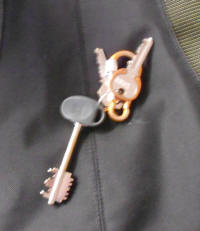
|
Okay .... So the keys to this place were so
cool we had to take a picture of them.
What we forgot is to get a picture of the door the big one
opened.
It was wooden, very old, and massive from the street. |
|
|
|
|
That evening, from the balcony of our B&B, we experienced
an extraordinary event.
Well over 1,000 people (clergy, priests, and common folk) took
to the streets to celebrate Corpus Domini / Corpus Christi
(Body of Christ).
|
|
 |
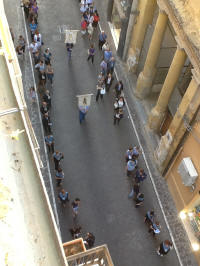 |
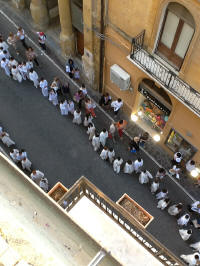 |
| |
|
|
Click here to see the processional video in full
(Just over 7 minutes on YouTube) |
|
  top
top
 
_________________________________________________________________________
Day 5:
All day in Agrigento & the Valley of the Temples
(Valle dei Templi)
| We got
up early and had breakfast on the terrace overlooking the
Valley of the Temples. The "Valley" is actually a high ridge.
We could see the Temple of Concord from the deck! Again the
GPS took us on a circuitous route, but in the end we were
delighted with out parking. We ended up at the bottom of the
ridge which meant that we took our time walking up hill to the
top in the relatively cool hours and came back down in the
heat of the day. |
|
|
|
Below
is the Temple of Concord, 5th century BC - one of the
most complete and best preserved Grecian temples in the world
(including Greece itself).
It has 34 columns, and inner chambers, & sanctuaries, still
partially intact. It is spectacular - one of the best we have
ever visited. |
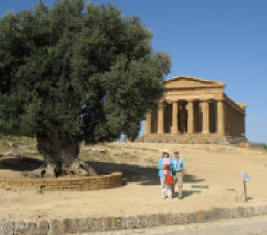 |
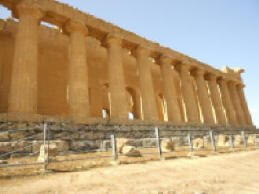 |
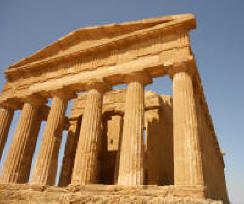 |
|
|
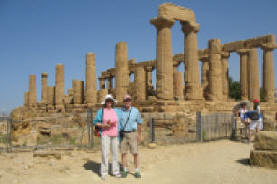 |
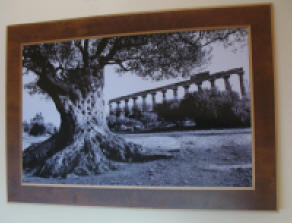 |
Temple of Hera
|
|
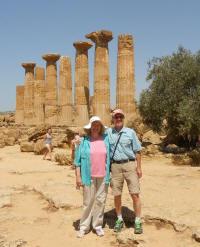 |
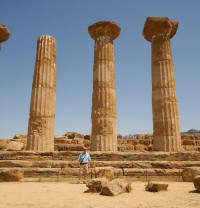 |
Temple of Hercules
|
|
| Necropolis
- the area of the tombs
In the Greek times these walls were used as part of the
defense of the city and temples.
The tombs were carved out between the 4th and 8th centuries
AD. Many of them had a domed tops that was fully painted with
religious symbols and / or scenes. These type of tombs
typically held two bodies.
In the picture of Bob sitting down you can see one of the
deep walls with multiple tombs carved into it.
It was hot enough that Bob finally decided to unzip the
leggings on his pants turning them into shorts. They stayed
that way for the rest of the trip. |
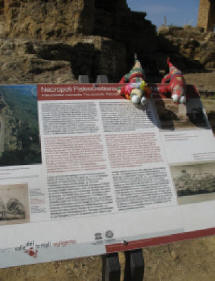
|
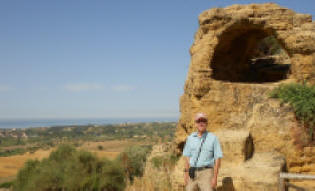 |
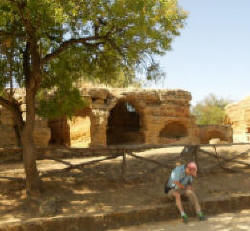 |
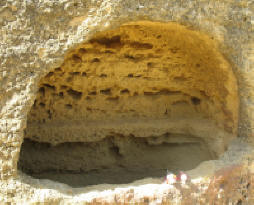 |
|
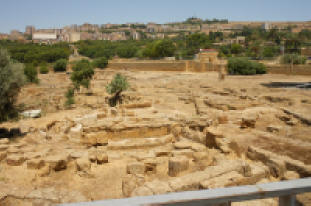
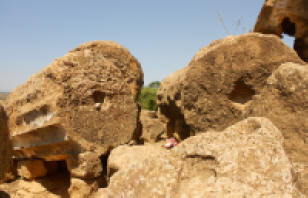 |
Temple of Olympian Zeus
(Tempio di Giove Olimpico)Built in approximately 480
BC, the temple of Olympian Zeus was massive. Because the
temple is in complete ruins, archeologists have to estimate
the size of the temple by looking at its stonework.
To the right, Bob is standing by a figure of Zeus that was
used to support the roof. What is so impressive is that
although it stands about 25 feet high, the total height of the
building was around 66 feet high (about 10 stories). So the
wall under this figure was over twice as tall as it is.
The temple is unusual in design because the columns used to
support it were actually walled in in between, and these
figures stood at the top, between the columns.
See artist renditions from
Wikipedia. |
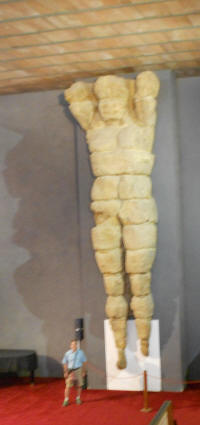 |
|
| |
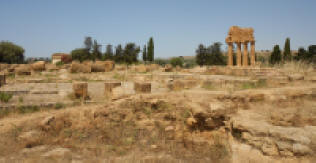
Temple of Castor
and Pollux
It has become the symbol of the entire site. |
|
|
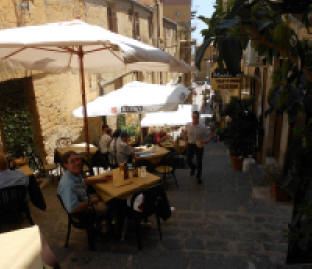 |
After exploring
the Valley, we came back to look around Agrigento.
The streets were narrow and at times very steep. In this
case, the restaurant where we stopped for lunch, had put
tables out on the wide steps for its customers.
In Sicily there is a big difference between a restaurant on
a cafe/bar. Restaurants serve large meals and open at 8:00 pm.
Cafes stay open all the time but only serve sandwiches.
This was a rare treat for us. Bob had some grilled fish and
Amy got some yummy grilled chicken.
A welcomed change from ham and cheese sandwiches.
|
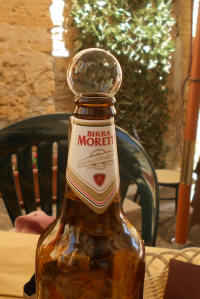 |
|
|
Since almost everything in town closes between noon and
3:00 (except the cafes), we only saw the inside of a few of
the churches.
This one was an unexpected beauty. Life sized angles, holy
men, birds and cherubs were covered the walls of the church.
In snow white, they contrasted the golden rays coming down
from the heavens behind them. Stunning.
There nun that met us at the entrance spoke a bit of
English and gave us a mini tour. When we heard the bells
ringing as a call to prayers, she told that it was her day to
be with the visitors and tourists and that she would just have
to pray twice as hard in the evening services.
We thanked her deeply and made a small donation. |
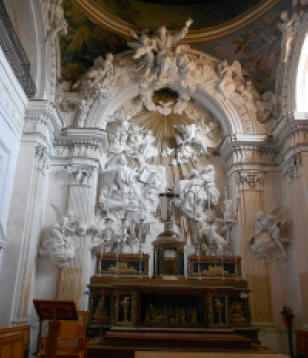 |
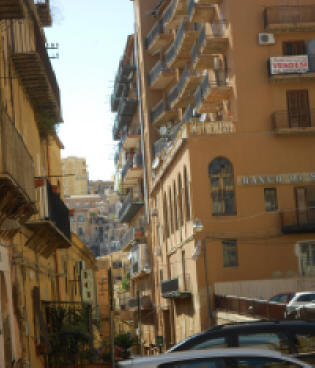 |
|
  top
top
 
_________________________________________________________________________
Day 6:
Check out & drive to
Piazza Armerina
then to Acireale / Etna
Santa
Caterina Hotel

On our drive, we passed numerous above-ground cemeteries. Reasons
differ as to why people do this. Sometimes it is the ground is
simply solid rock - sometimes the water table is to high, making the
coffins float after a period of time. These cemetaries have been
called "cities of the dead" for their narrow and twisting "streets". |
|
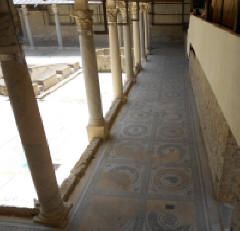 |
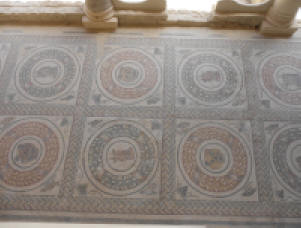 |
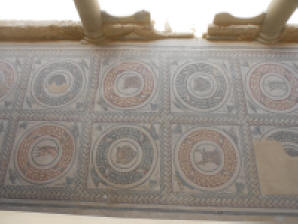 |
|
|
|
|
|
The Villa del Casale is located in the city of
Piazza Armerina.
It is a huge estate from the 3rd and 4th centuries AD and
basically every room in the villa has an incredibly detailed
mosaic floor. The mosaics were preserved by a flood that
buried them in mud in the 12th century. While we were there we
saw archeologists still excavating areas.
After coming in the entrance, you are greeted by a square
courtyard that had a fountain in the center (now dry). Around
the courtyard is a columned walk entirely covered by different
animals in circular designs. The columns originally all had
stone dolphins at the base (picture on right).
Our point and shoot camera were not very effective at
capturing the detail and workmanship of the mosaics. We would
encourage you to search Google images for "Villa del Casale".
However, be assured that none of the images here are painted -
in some rooms the mosaic tiles are so small and tight that
they do not show up well. |
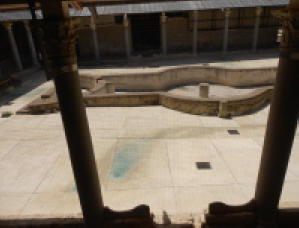 |
|
|
|
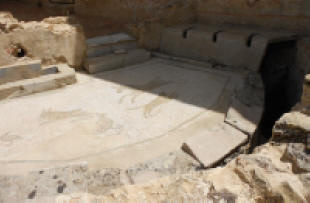 |
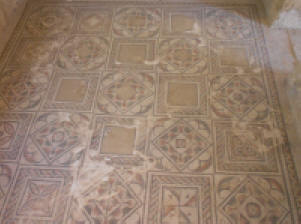 |
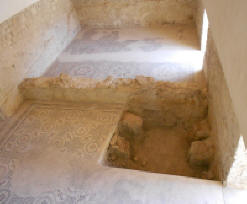 |
|
|
|
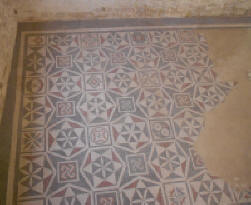 |
The room above and to the left is the bathroom. The toilet
seats are side-by-side in the background of the picture. We
have learned that this was common practice at that time. In
some places slaves would arrive at the bathroom to warm the
"seat" and save a place for their masters. Bathrooms were a
community meeting place where talking, reading, and laughing
was the norm.
Although some mosaics were purely geometric in design, many
included animals, people, or symbolic representations of items
such as pomegranates - the symbol for fertility.
Still others told stories (some believed to be relating
real events in the family's life).
Below and centered is the story of a hunt.
Below and to the right is a day of fishing with the wings
representing good luck during the day. |
|
|
|
 |
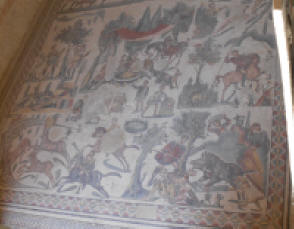 |
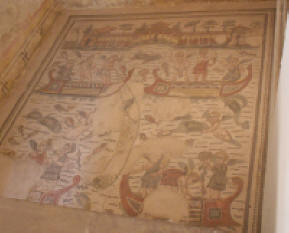 |
|
|
|
|
| Down
one of the main interior corridors, was a massive mosaic. It
showed how wild animals were caught from all over the known
world, put in large crates, and shipped on fast boats to Rome
to be use in the Amphitheatre.
The first picture shows only the mid point of the hall. You
can also see that the floor is uneven with rolling areas. It
is believed this intentional so that water would not pool. |
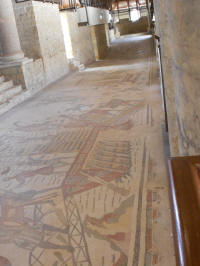 |
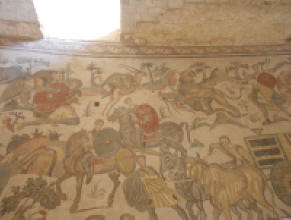 |
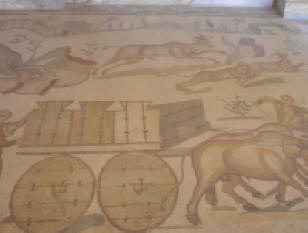 |
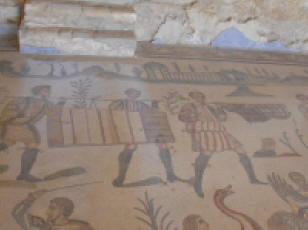 |
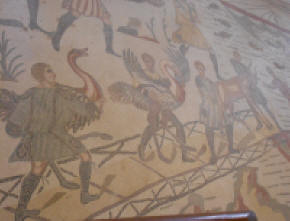 |
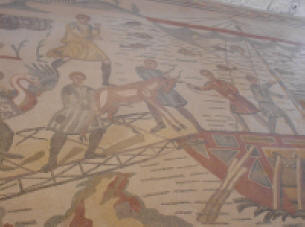 |
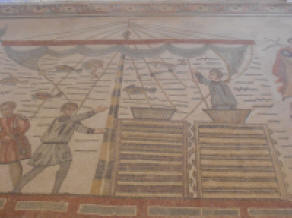 |
 |
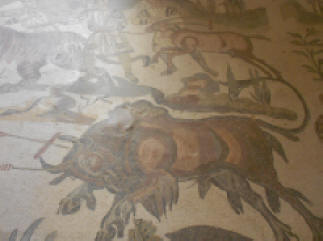 |
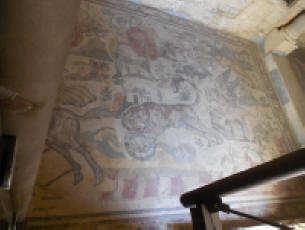 |
|
|
|
|
|
|
|
The Chamber of the Ten Maidens (or more commonly
referred to as The Bikini Girls), gives an important
insight into women's sports and clothing styles. These are ten
women competing in different sports of the time.
In the corner is part of a mosaic from an earlier time.
Also, on the walls are the remains of fresco paintings that
decorated the room. |
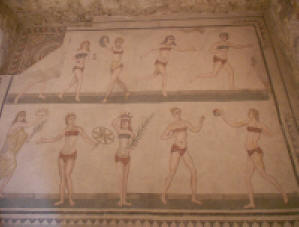 |
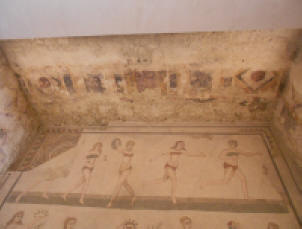 |
|
|
|
|
| The mosaics weren't
only on the interior of the villa. They covered large areas of
outside walkways between the different and connected rooms. |
|
|
|
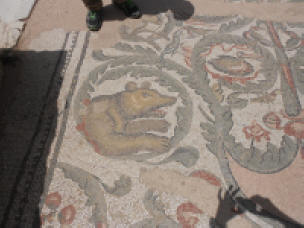 |
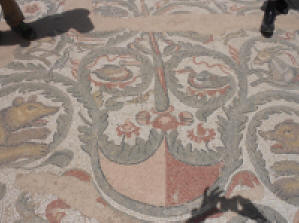 |
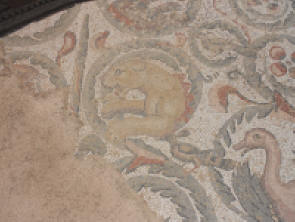 |
 |
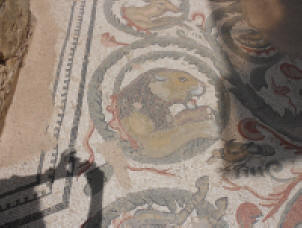 |
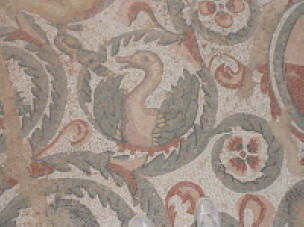 |
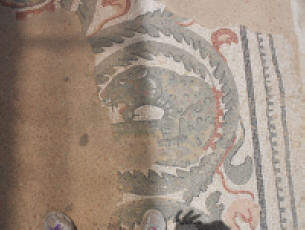 |
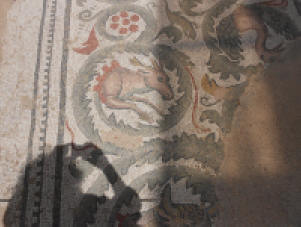 |
|
|
|
|
|
| The rooms below
were mostly bedrooms with symbolic designs. |
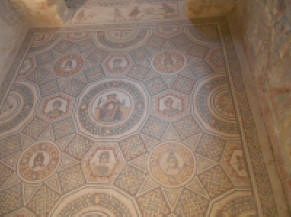 |
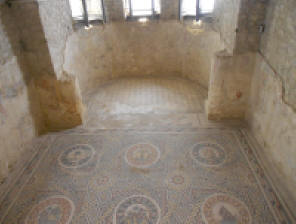 |
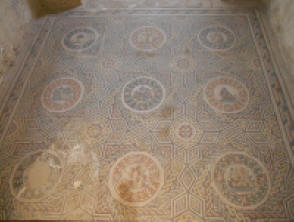 |
The rooms blow were
covered in mythical images and they were fantastic!
Although the middle picture looks like it is a wall, it is the
floor - just an odd camera angle. |
 |
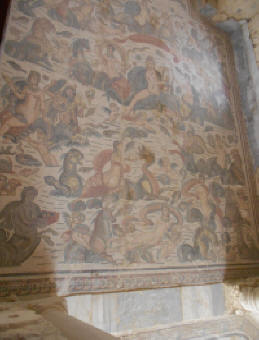 |
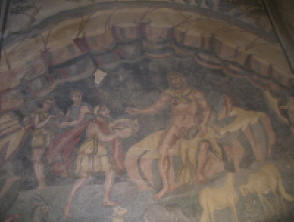 |
|
|
|
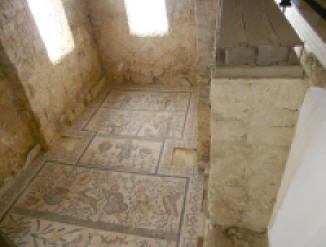 |
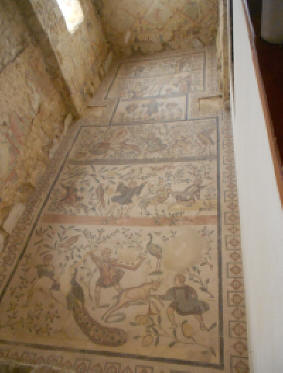 |
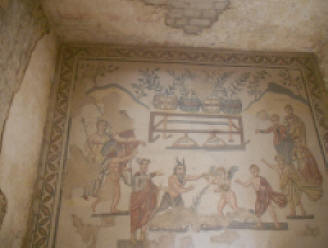 |
|
|
|
|
After a short drive we checked into our
Santa Caterina
hotel in Acireale so we could get up
early and explore Mount Etna.
|
|
  top
top
  _________________________________________________________________________
_________________________________________________________________________
Day 7:
All day at Etna
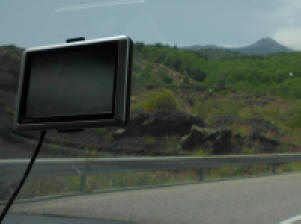 |
Our first view of Etna! |
|
|
|
|
Mount Etna is Europe's largest active
volcano. It is, however, in geological terms a "recent"
volcano that is only two million years old. In 1381 and 1669
the lava flow during these eruptions reached to Catania (about
28 miles). The very top is about 11,000 feet high. |
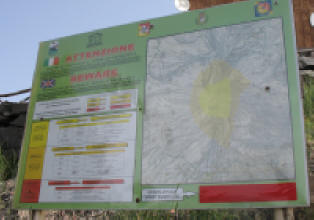 |
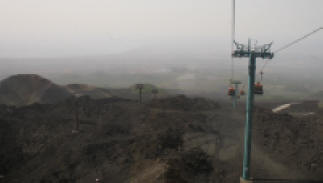 |
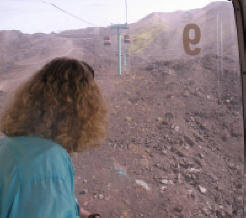 |
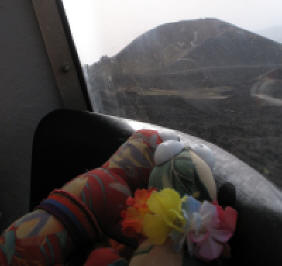 |
At the base of
Etna is a little tourist town and it is the start of the cable
car we were going to ride up on. The first sign we encountered
warned that the volcano was on a red alert danger level. (It
had erupted the day we were in Palermo.)
The cable car gave great views of the volcano, its vents,
and the countryside below. It also acts as a ski lift in the
winter. |
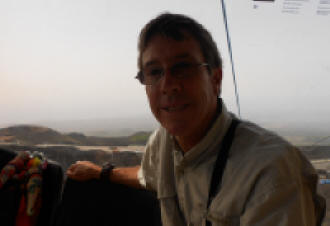 |
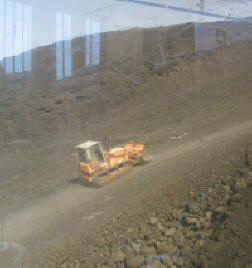 |
Bulldozers work
constantly to keep a path open. The winds can get high blowing
ash and rock around. We took a picture of our shoes to see how
dirty they would get. I guess they were dirty enough when we
started because we didn't really see any difference on the way
down.
After getting off the cable car, we hopped on a 20 person
jeep to go as high as we could under the current warning
conditions. |
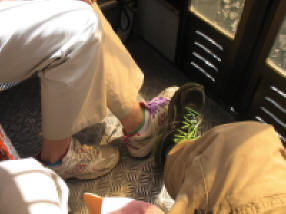 |
|
|
|
|
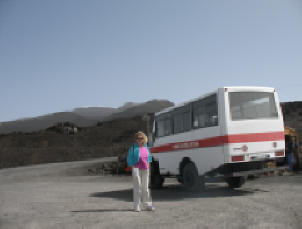 |
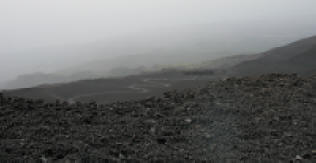 |
On our way up, we saw these tiny little
people on the edge of the crater we were to visit. On guy in a
red jacket slipped over the edge. Fortunately he caught
himself and the group helped him back onto the path.
But the rocks (small boulders) that he
dislodged rolled down picking up incredible speed as they
went. |
|
|
|
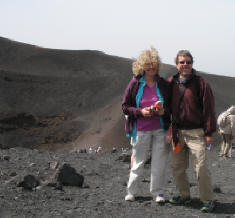 |
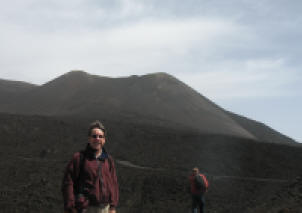 |
When we got off the Jeep, it looked like we
were walking on the moon!
We ended up on a side vent (mini volcano
cone) that I think is called Torre del Filosofo at 9,500 ft?).
"Mini" is a relative word - small compared to Etna, huge in
and of itself.
Notice the jackets? Yea - it was cold up
there! They even rented coats for those who hadn't done their
research. |
|
|
|
|
It started out okay ... crossing a wide
sloping path to the other side of the cone. We could see down
into the vent from the mid point. |
|
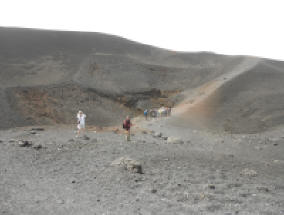 |
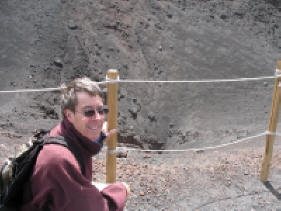 |
 |
|
|
|
|
And then ... not so much. The trail turned
into a tiny little pass of loose, round volcanic pebbles going
all the way around the rim. Add to that a stiff wind was
blowing reaching gusts of 50-60 mph. And we were suppose to
walk around the rim with this group of people and the guide? |
|
|
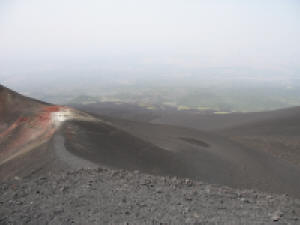 |
Needless to say,
Bob was excited ... Amy terrified. |
|
|
|
|
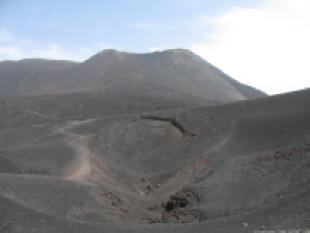 |
 |
Amy said it then and will say it now,
"No way in h-e-double-candle-sticks!"
Amy proudly wimped out.
The picture to the far left (when clicked)
shows her walking back to wait and pray.
The next is the blown up version.
Amy and her VT bag are half way back
(so you know what to look for in the first one.) The
group at the top are waiting to start their adventure.
On return, Bob said that it was "a tad
windy".
He tried to walk with his arms tight to his body so the gusts
wouldn't send him down the side. |
|
|
|
|
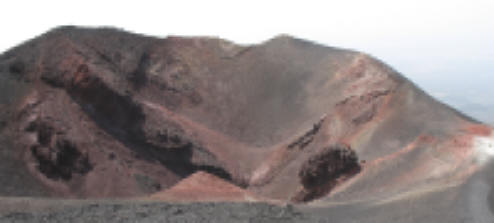 |
This is the big view of the crater with the
path just starting off on the right. Evidently, it got even
narrower at the top.
Ummm ... no thanks! |
|
|
|
|
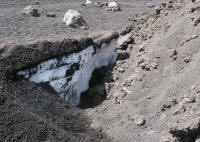 |
Buried under the rock and ash are layers of
snow pack. They are all over the place. Even the warming of
the black surface is not enough to completely melt them.
Bob has a firm grip on K&K with all the
wind.
In the background you can see the the sea.
Beautiful! |
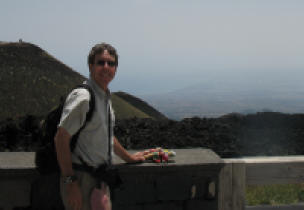 |
|
|
|
|
  top
top
 
_________________________________________________________________________
Day 8:
Explore Acireale &
take an afternoon to relax
| For
the first time in our travels we basically took a vacation day
on our vacation to slowly tour Acireale, sit on our patio and
the hotel's patio, and actually take a mid-afternoon nap. And
we saw the most extraordinary thing .. two airplanes that
would, in turn, fly overhead, grab water from the Ionian Sea,
and presumably dump it on fires started from Etna's recent
eruption. It was awesome to watch as the winds changed
throughout the day. |
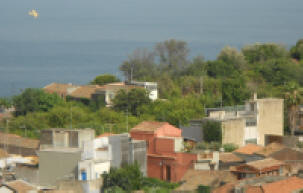 |
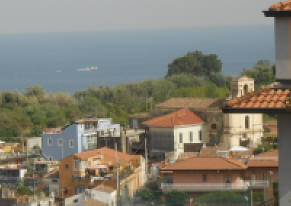 |
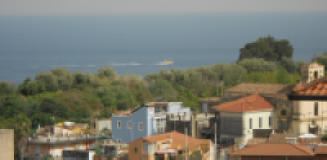 |
| |
|
|
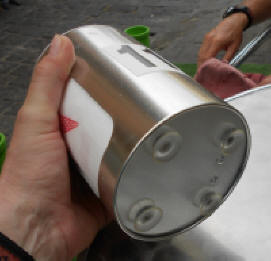 |
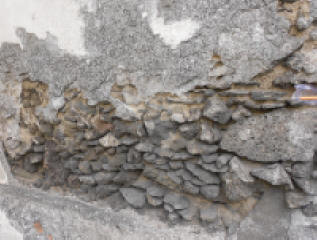 |
Although not like
Etna, it was windy. Amy found a paper napkin holder with a
simple but ingenious design / modification -
four little suction cups glued to the bottom! Brilliant!
Acireale is build on ancient lava flows and over centuries
has been destroyed over and over again whether by lava or
earthquakes. After the 1693 quake, it was rebuilt in the
Baroque style which is still in place today. In many areas you
can see the lave rocks that make up a majority of the
residential and commercial buildings. |
|
| |
|
|
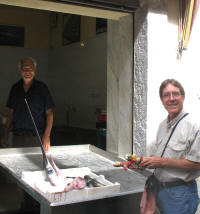
|
After a short
walk, we found the fish market where Italian sellers would
call to the masses to entice them to their stalls and
hopefully them to purchase some of their catch of the
day.
This gentleman was delightful showing us his fresh
swordfish head.
Then on to another plaza with a Baroque style church. |
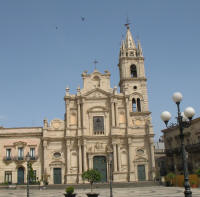 |
|
| The Acireale
Cathedral has two bell towers covered in multicolored tiles
and was built in the late 1500s.
The few churches we visited all had electric candles to
light for prayers ... Some you dropped a coin in at the next
available candle lit up - some you put in your coin and
flipped a toggle switch
for your choice of candle to light up.
Again, it was sad / lacking to and for us.
But we understood the fire hazards. |
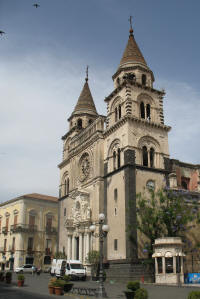 |
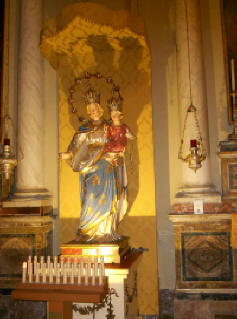 |
|
|
|
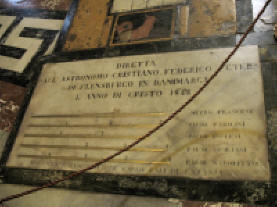 |
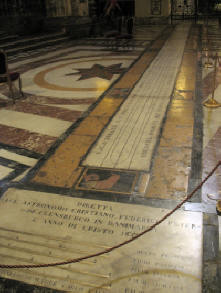 |
The transept floor
is marked with a meridian line of various precious
stones and inlayed metal.
It was done by a Danish astronomer in 1843.
As we sat in the Cathedral we fortunate to hear the
organist practice for an up-coming service.
It was ethereal!
|
|
|
|
|
  top
top
 
_________________________________________________________________________
Day 9:
Check out & drive to
Siracusa (Syracuse) - visit Ortygia (Ortigia)
Grand
Albergo Alfeo
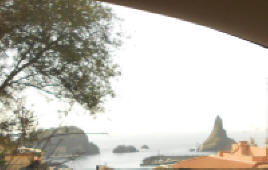 |
|
On our way to Syracuse we passed the Isle of
Cyclops
(Isole dei Ciclopi). This towering rock formation was,
according to Homer, hurled into the Ionian Sea by Polyphemus
in an attempt to kill Ulysses (his Roman name, Odysseus in
Greek) after Ulysses had blinded him.
To see the full story in Wikipedia,
click here. |
|
Our hotel did not have its own parking lot, but there was one
just down the street. It was paid parking (which presented its
own set of challenges due to being able to read and understand
the pay-for kiosk). We ended up with three separate tickets
that we left on Baby Brutus' dash hoping the car and the fees
would work out for the next day and a half. It did - to our
great relief. |
|
After check in, we
walked down to
Ortygia (Ortigia) - a small island with
connecting bridges to Syracuse proper. |
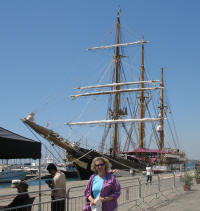 |
At the
dock was a reproduction of a 1700s sailing ship. Built for
speed and trade, these ships dominated the peace time seas. |
|
|
|
|
|
Castello Maniace (the fort at the tip of Ortygia) This
fort / castle / prison is situated at the southern tip of the
island of Ortygia.
It looks to the Porto Grande (large port) on one side and the
Porto Piccolo (small port) on the other.
A three minute fantastic musical History.com video summing up
the Peloponnesian Wars.
|
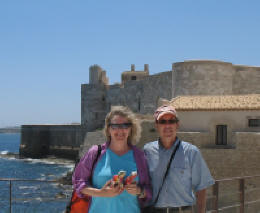 |
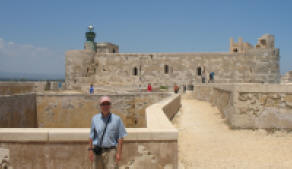 |
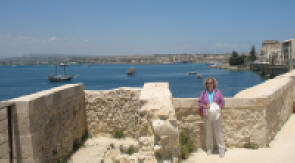 |
This area fascinated us. We had both read the book "The Tides
of War" by Steven Pressfield (Historical Fiction -
review).
Basically, in the last of the Peloponnesian Wars (431-404 BC),
Sparta and Athens were fighting over Sicily's territories.
With Alcibiades becoming a great general in the Athenian army,
he and his troops set sail to Porto Grande (right here!) to
defeat the Spartans.
The Athenians were known for their war ships, while the
Spartans were known for their military land tactics.
Shortly before they arrived, Alcibiades was accused of being a
traitor and was sentenced to death.
He escaped and went to Sparta (Athena's enemy), gave them
all the information & plans he had helped to develop,
and helped them to plan a defense. Sparta sent only one man to
be the commander, Gylippus.
After all, they said, "One Spartan is all we need."
Sparta defeated Athens in this very port (did we say and we
are here?!). So, Alcibiades took off to join with the Persians
against his former people.
After some misadventures there, he left to go back to Athens -
they welcomed him home as a hero even though he was the reason
they were defeated. After more adventures he was finally
hunted down and executed.
The Peloponnesian Wars took so many resources and so much
time that eventually
both Athens, Sparta, and all of Greece fell to the Romans in
146 BC.
|
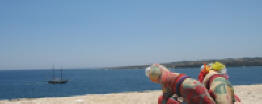 |
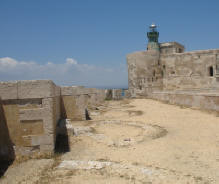
Cannon turrets |
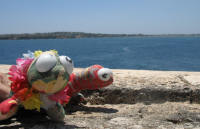 |
|
Our
next stop was at the Duomo, Tempio di Minerva.
It was not only spectacular but unique in that it incorporates
parts of a
6th century BC temple dedicated to Athena, a later temple
dedicated to Minerva, and is now, after major modifications,
in the Baroque style (1728-1753),and has become known as "The City's
Cathedral".
Again we saw the stone inlay / mosaic floors throughout.
And again we marveled at the differences of the hardness of
the precious stones and rock they used. Due to the individual
harnesses, the floors had discernable high and low points from
being worn down by centuries of foot steps over the centuries. |
 |
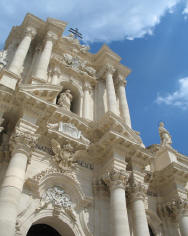 |
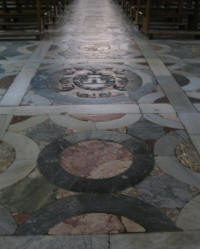 |
|
|
|
|
To
archeologists agree, this church is remarkable and unusual in
one of the most dramatic and distinctive ways -
it was built around exposed Roman / Grecian
columns.
The inner arches and columns come from a much later time, and
with them, the life sized statues and artworks that fill the
niches and naves.
On the supporting walls - visible inside and out - are the
columns from the temple of Athena (6th century BC). |
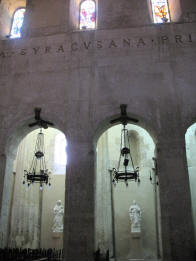 |
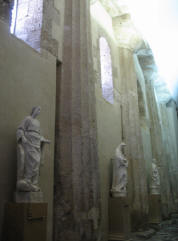 |
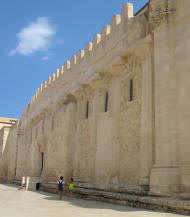 |
|
|
|
|
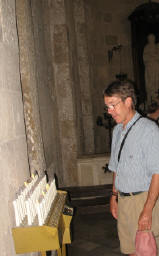
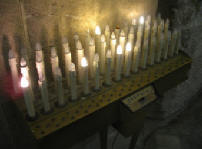 |
|
To the far left are
two pictures
of an alter which features
electronic candles
(again).
This one allows you to flip the toggle switch
to turn on your desired light.
The world is forever changing.
In some things, we are not sure how
to keep up with the times. :)
----------------------------------------
Sicily has a passion for its sacred relics.
In the photo to the right is a holy shrine.
The painting hangs above a small,
glass fronted box that holds some of his sacred bones. |
|
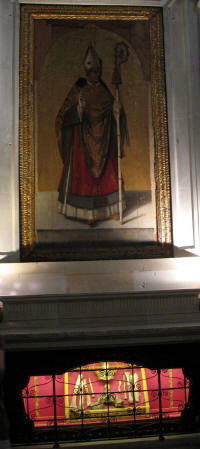 |
|
|
|
|
  top
top
 
_________________________________________________________________________
Day 10:
Siracusa (Syracuse)
|
In 1955, Siracusa (Syracuse) created the
Neapolis Archeological Zone
so that many of the largest and most ancient sites could be
visited with a single ticket.
We were lucky to make it there very
early and be able to experience the site basically alone,
and just ahead of the tourist bus groups.
|
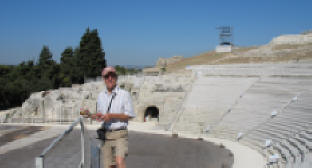 |
The Greek Theatre
Dating to the 5th century BC, this theatre has undergone
renovations and enlargements
for several millennia making it one of the largest in the
world.
Bob is standing on one side of the theatre which is 453
feet in diameter. Today's football field is 300 feet long in a
straight line - this is built in a semi-circle and carved into
the rock. Incredible!
Still used as a theatre, we arrived after a production was
put on so a temporary flooring
had been laid down to protect the ancient stage. |
On the top, and to the western side, were avenues to people
to arrive and leave. In the past they were decorated with
small, square plaques of stone
and / or alters to heroes and family members past and
present. Cart wheel tracks and pathways are still present in
the roads. |
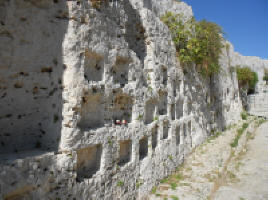 |
 |
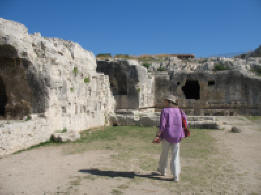 |
|
Grotta del Museion
This area was carved out of the rock to provide water to
the theatre.
Channels and aqueducts were built to provide underground water
from this spring for cleaning areas / toilets and
to fill the bowl of the stage so that small boats could
reenact battles.
The spring was in the shade flowing as a waterfall. The
heat in the sun, cool air by the flow of underground water,
and Zen sound allowed us to
really feel the time and people that had built, enjoyed, and
passed this way in ancient times.
Further on around the top of the theatre, were larged domed
"rooms". We were unsure whether these we were
more (and significantly larger) alters of heros or possible
food vending areas. |
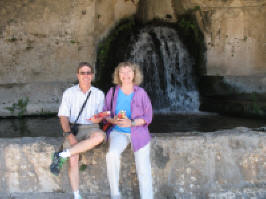 |
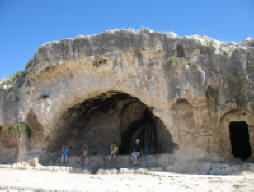 |
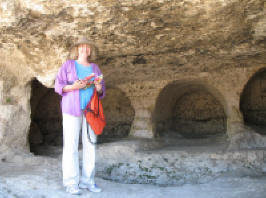 |
|
|
|
|
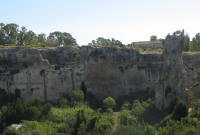 |
We left the Greek Theatre area and started to walk down to the
second quadrant of the Archeological Zone toward the stone
quarries called Lotomie.
Almost in the center, and a bit to the left of the picture
on the left is the entrance to the stone main quarry for this
area.
But to get the you had to go through this delightful maze
of tree covered paths and ancient lanes.
Bob and K&K are to the right. |
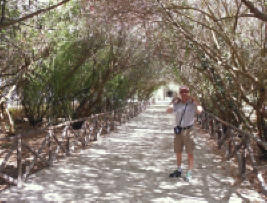 |
|
|
|
And then you arrive at the most impressive entrance to a
stone quarry that we've experienced in our travels.
Orecchio di Dioniso (The Ear of Dionysius)
(Not to be confused with the Greek god, Dionysus ... this area
referred to the King Dionysius I that used it as a prison
and was said to be able to hear all the the prisoners'
whisperings and gossip.)
It stands 75.5 feet high and heads back to a depth of 213
feet.
That is approximately seven stories high and nearing field
goal range on a football field (300 feet).
We were lucky to be there before the tour bus crowds got
there and had to place virtually to our selves.
Here is a link to
the
ghostly and eerie sounds of the pigeons that live here.
(34 seconds)
It is the echo that is so impressive.(Please forgive the video
portion - we were trying to record the sounds.)
|
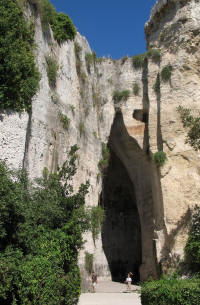 |
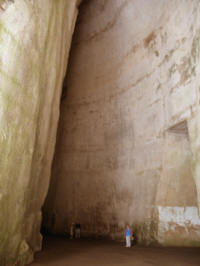 |
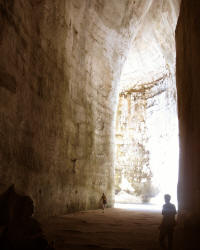 |
|
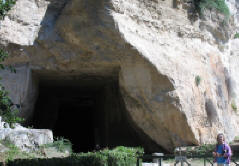 |
To the left is the is another cavernous lotomie. The quarrying
was a fantastic art in of of itself.
Altar of Hieron II is pictured on the right. It was
about two football fields in length and one to one and a half
wide.
It was dedicated to Zeus and on major occasions as many as
400 bulls were sacrificed at the temple at the same
time. |
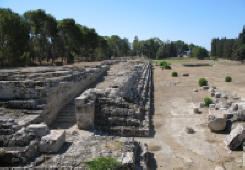 |
|
 |
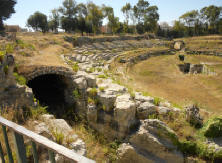 |
At the far side of the zone was the ruins of a Roman theatre.
Much smaller and in greater disrepair, this site was "newer"
than the Greek theatre by probably half a century.
It had more tunnels and ramps, and was only slightly
smaller in size, but was more complex in design as it was
"newer" in build. |
|
This is a puzzler - we can't remember the name of the building
to find the information.
It was a little church / museum that has the full skeletal
remains of a person buried here.
The bones rest in their found position under hardwood
floors and glass windows.
|
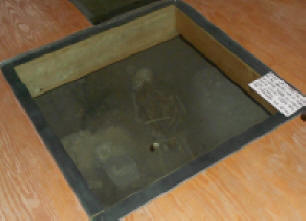 |
|
|
|
|
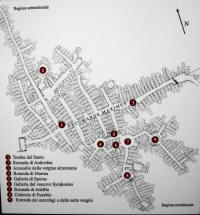 |
The Catacombs of San Giovanni (St. James)
No pictures were allowed, so we had to rely on the posters
outside to document this unreal experience.
In Greek times the few tunnels were dug for aqueducts,
while the large vaulted areas were used as cisterns. When the
Romans came, Christians (who were not allowed to bury their
dead within city limits) enlarged the tunnels and created the
catacombs.
They date back to 360-315 BC and stayed un use up to the
5th century AD. Over that time more then 20,000 people were
buried here. The large cistern areas were used for
prominent families. |
From
this web site: "This underground cemetery was built as
mass burial ground even for the poorer members of the
population. The rock, which was easy to work with, made it
possible to create, here and in other Syracusan catacombs, a
very particular type of "serial" burial, called by
archaeologists "polysome arcosolium". These are very long
niches in the walls, as wide as a human body and tall enough
to be able to insert a corpse, in which a first body was
entombed with a stone slab, after which in the new space thus
created a second corpse was entombed and sealed by another
slab, and so forth. In these "tunnel-graves" of almost
industrial composition it was possible to lay as many as 30
corpses side by side.
When the space available in this catacomb was exhausted, they
proceeded as best they could, employing every corner that
remained free, on the walls and even on the floor, also
invading the cisterns / chapels, one of which survives filled
with the sarcophagi of a group of nuns from the Byzantine
period."
|
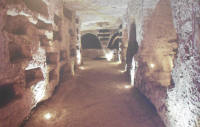 |
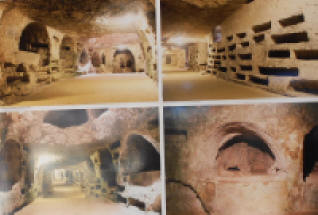 |
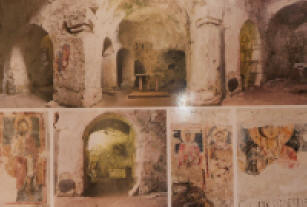 |
|
The sarcophagus below had the most important scenes from the
Old and New Testaments and in the center was a portrait of the
couple laid to rest in it.
The picture on the right is a marble slab that covers the
grave and has three holes in it. The three holes were each
connected to tubes that ran down and into the deceased mouth.
One anniversary of the person's death, in a rite called "refrigerium"
(meaning refreshment), family members would go to the grave
and pour wine, milk, and honey down the holes. They were
celebrating "dies natalis" or the day of the birth of the
spirit to eternal life. |
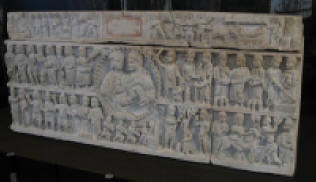 |
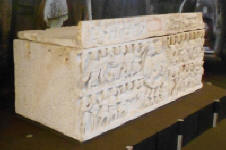 |
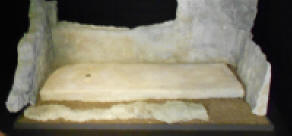 |
|
We ended the day
in the air-conditioned
Museo Archeologico Regionale - Palol Orsi.
We loved this little lion from the 7th century BC. The
workmanship was magnificent.
He was a little container possibly used for perfume or as an
oil lamp. |
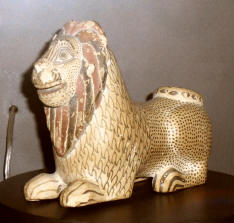 |
Below are examples of the pottery vessels dating from the 15th
to 9th centuries BC.
We were fascinated with the large "bowl" with a pedestal
and back plate. Large or small in design, each one had a
handle on the back. We have searched to web to find out its
purpose, but to no avail.
Bob is standing next to one of the largest and earliest
made pots in the museum. |
|
|
|
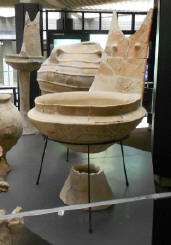 |
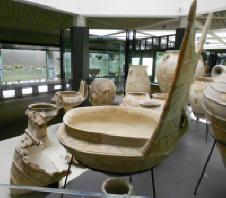 |
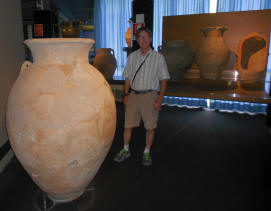 |
|
|
|
| This is a slab
that covered a tomb niche.
Its sign to the left says it all. |
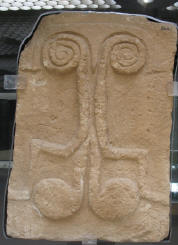 |
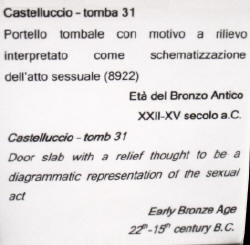 |
| And of
course, more mosaics. |
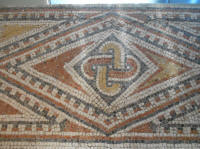 |
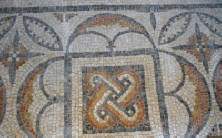 |
 |
|
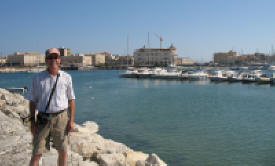 |
We ended the day
taking a walk down to the pier that was a block or so from our
hotel. People were sunbathing, fishing, and just relaxing. |
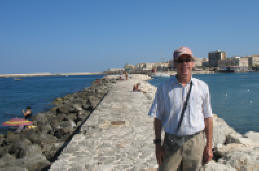 |
|
  top
top
 
_________________________________________________________________________
Day 11:
Check out & drive to
Catania
Drop off car & see city
Al
Duomo Inn
|
After driving to Catania and dropping off
the car, we checked into our B&B. It was family run with only
a few rooms, but centrally located. The guy that owned it set
up our taxi trip to the airport the for the next morning - we
would be leaving around 5:00 in the morning. So, with all the
business settled and early flight, we decided to just relax
and stay close to home. We ended up in the Piazza Duomo,
the main plaza in the town. |
|
  top
top
 
_________________________________________________________________________
Day 12:
Fly homeThe sun was
rising as we got to the airport and Etna was off in the distance
still puffing smoke.
The flights home were uneventful and the dogs were happy to see us.
A good time was had by all!
|
  top
top
 
_________________________________________________________________________
|



